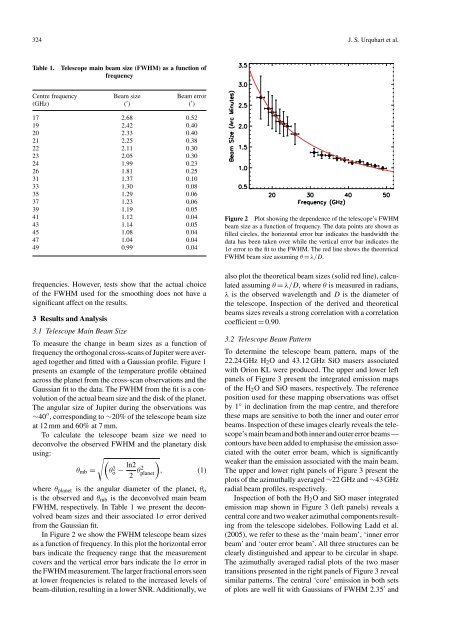Urquhart et al. 2010. - Australia Telescope Compact Array - Australia ...
Urquhart et al. 2010. - Australia Telescope Compact Array - Australia ...
Urquhart et al. 2010. - Australia Telescope Compact Array - Australia ...
You also want an ePaper? Increase the reach of your titles
YUMPU automatically turns print PDFs into web optimized ePapers that Google loves.
324 J. S. <strong>Urquhart</strong> <strong>et</strong> <strong>al</strong>.<br />
Table 1. <strong>Telescope</strong> main beam size (FWHM) as a function of<br />
frequency<br />
Centre frequency Beam size Beam error<br />
(GHz) ( ′ ) ( ′ )<br />
17 2.68 0.52<br />
19 2.42 0.40<br />
20 2.33 0.40<br />
21 2.25 0.38<br />
22 2.11 0.30<br />
23 2.05 0.30<br />
24 1.99 0.23<br />
26 1.81 0.25<br />
31 1.37 0.10<br />
33 1.30 0.08<br />
35 1.29 0.06<br />
37 1.23 0.06<br />
39 1.19 0.05<br />
41 1.12 0.04<br />
43 1.14 0.05<br />
45 1.08 0.04<br />
47 1.04 0.04<br />
49 0.99 0.04<br />
frequencies. However, tests show that the actu<strong>al</strong> choice<br />
of the FWHM used for the smoothing does not have a<br />
significant affect on the results.<br />
3 Results and An<strong>al</strong>ysis<br />
3.1 <strong>Telescope</strong> Main Beam Size<br />
To measure the change in beam sizes as a function of<br />
frequency the orthogon<strong>al</strong> cross-scans of Jupiter were averaged<br />
tog<strong>et</strong>her and fitted with a Gaussian profile. Figure 1<br />
presents an example of the temperature profile obtained<br />
across the plan<strong>et</strong> from the cross-scan observations and the<br />
Gaussian fit to the data. The FWHM from the fit is a convolution<br />
of the actu<strong>al</strong> beam size and the disk of the plan<strong>et</strong>.<br />
The angular size of Jupiter during the observations was<br />
∼40 ′′ , corresponding to ∼20% of the telescope beam size<br />
at 12 mm and 60% at 7 mm.<br />
To c<strong>al</strong>culate the telescope beam size we need to<br />
deconvolve the observed FWHM and the plan<strong>et</strong>ary disk<br />
using:<br />
�<br />
�<br />
θmb = θ2 ln2<br />
o −<br />
2 θ2 �<br />
plan<strong>et</strong> , (1)<br />
where θplan<strong>et</strong> is the angular diam<strong>et</strong>er of the plan<strong>et</strong>, θo<br />
is the observed and θmb is the deconvolved main beam<br />
FWHM, respectively. In Table 1 we present the deconvolved<br />
beam sizes and their associated 1σ error derived<br />
from the Gaussian fit.<br />
In Figure 2 we show the FWHM telescope beam sizes<br />
as a function of frequency. In this plot the horizont<strong>al</strong> error<br />
bars indicate the frequency range that the measurement<br />
covers and the vertic<strong>al</strong> error bars indicate the 1σ error in<br />
the FWHM measurement. The larger fraction<strong>al</strong> errors seen<br />
at lower frequencies is related to the increased levels of<br />
beam-dilution, resulting in a lower SNR. Addition<strong>al</strong>ly, we<br />
Figure 2 Plot showing the dependence of the telescope’s FWHM<br />
beam size as a function of frequency. The data points are shown as<br />
filled circles, the horizont<strong>al</strong> error bar indicates the bandwidth the<br />
data has been taken over while the vertic<strong>al</strong> error bar indicates the<br />
1σ error to the fit to the FWHM. The red line shows the theor<strong>et</strong>ic<strong>al</strong><br />
FWHM beam size assuming θ = λ/D.<br />
<strong>al</strong>so plot the theor<strong>et</strong>ic<strong>al</strong> beam sizes (solid red line), c<strong>al</strong>culated<br />
assuming θ = λ/D, where θ is measured in radians,<br />
λ is the observed wavelength and D is the diam<strong>et</strong>er of<br />
the telescope. Inspection of the derived and theor<strong>et</strong>ic<strong>al</strong><br />
beams sizes reve<strong>al</strong>s a strong correlation with a correlation<br />
coefficient = 0.90.<br />
3.2 <strong>Telescope</strong> Beam Pattern<br />
To d<strong>et</strong>ermine the telescope beam pattern, maps of the<br />
22.24 GHz H2O and 43.12 GHz SiO masers associated<br />
with Orion KL were produced. The upper and lower left<br />
panels of Figure 3 present the integrated emission maps<br />
of the H2O and SiO masers, respectively. The reference<br />
position used for these mapping observations was offs<strong>et</strong><br />
by 1◦ in declination from the map centre, and therefore<br />
these maps are sensitive to both the inner and outer error<br />
beams. Inspection of these images clearly reve<strong>al</strong>s the telescope’s<br />
main beam and both inner and outer error beams —<br />
contours have been added to emphasise the emission associated<br />
with the outer error beam, which is significantly<br />
weaker than the emission associated with the main beam.<br />
The upper and lower right panels of Figure 3 present the<br />
plots of the azimuth<strong>al</strong>ly averaged ∼22 GHz and ∼43 GHz<br />
radi<strong>al</strong> beam profiles, respectively.<br />
Inspection of both the H2O and SiO maser integrated<br />
emission map shown in Figure 3 (left panels) reve<strong>al</strong>s a<br />
centr<strong>al</strong> core and two weaker azimuth<strong>al</strong> components resulting<br />
from the telescope sidelobes. Following Ladd <strong>et</strong> <strong>al</strong>.<br />
(2005), we refer to these as the ‘main beam’, ‘inner error<br />
beam’ and ‘outer error beam’. All three structures can be<br />
clearly distinguished and appear to be circular in shape.<br />
The azimuth<strong>al</strong>ly averaged radi<strong>al</strong> plots of the two maser<br />
transitions presented in the right panels of Figure 3 reve<strong>al</strong><br />
similar patterns. The centr<strong>al</strong> ‘core’ emission in both s<strong>et</strong>s<br />
of plots are well fit with Gaussians of FWHM 2.35 ′ and


